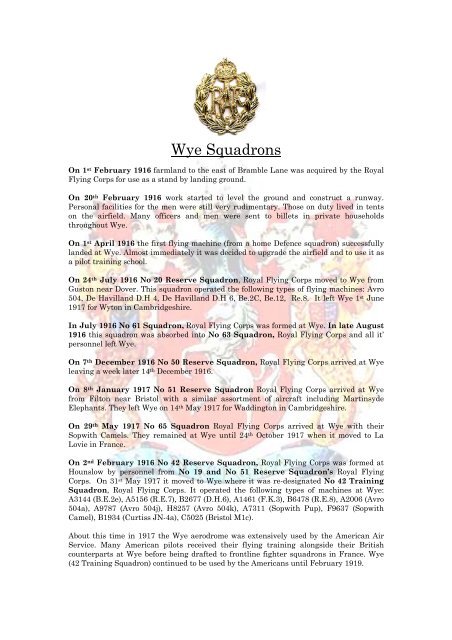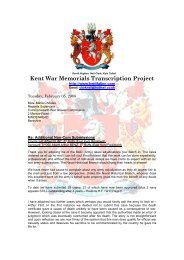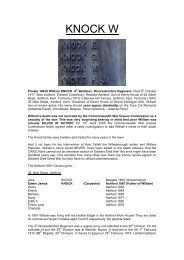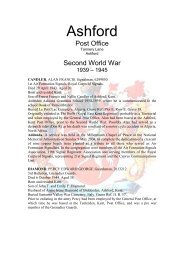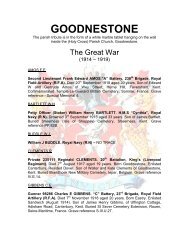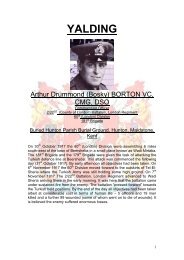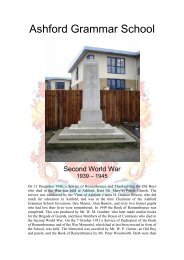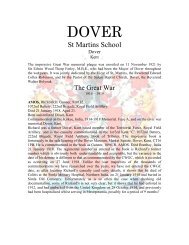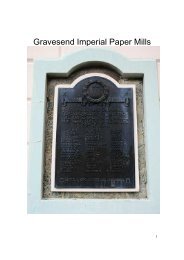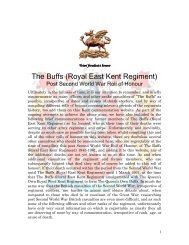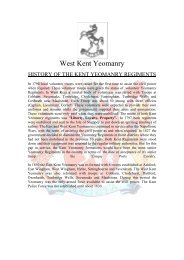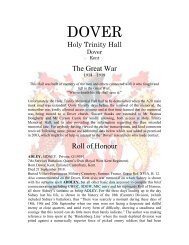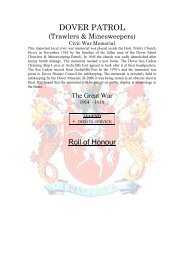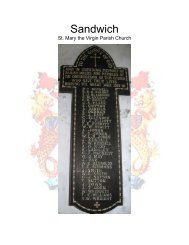You also want an ePaper? Increase the reach of your titles
YUMPU automatically turns print PDFs into web optimized ePapers that Google loves.
<strong>Wye</strong> Squadrons<br />
On 1 st February 1916 farmland to the east of Bramble Lane was acquired by the Royal<br />
Flying Corps for use as a stand by landing ground.<br />
On 20 th February 1916 work started to level the ground and construct a runway.<br />
Personal facilities for the men were still very rudimentary. Those on duty lived in tents<br />
on the airfield. Many officers and men were sent to billets in private households<br />
throughout <strong>Wye</strong>.<br />
On 1 st April 1916 the first flying machine (from a home Defence squadron) successfully<br />
landed at <strong>Wye</strong>. Almost immediately it was decided to upgrade the airfield and to use it as<br />
a pilot training school.<br />
On 24 th July 1916 No 20 Reserve Squadron, Royal Flying Corps moved to <strong>Wye</strong> from<br />
Guston near Dover. This squadron operated the following types of flying machines: Avro<br />
504, De Havilland D.H 4, De Havilland D.H 6, Be.2C, Be.12, Re.8. It left <strong>Wye</strong> 1 st June<br />
1917 for Wyton in Cambridgeshire.<br />
In July 1916 No 61 Squadron, Royal Flying Corps was formed at <strong>Wye</strong>. In late August<br />
1916 this squadron was absorbed into No 63 Squadron, Royal Flying Corps and all it’<br />
personnel left <strong>Wye</strong>.<br />
On 7 th December 1916 No 50 Reserve Squadron, Royal Flying Corps arrived at <strong>Wye</strong><br />
leaving a week later 14 th December 1916.<br />
On 8 th January 1917 No 51 Reserve Squadron Royal Flying Corps arrived at <strong>Wye</strong><br />
from Filton near Bristol with a similar assortment of aircraft including Martinsyde<br />
Elephants. They left <strong>Wye</strong> on 14 th May 1917 for Waddington in Cambridgeshire.<br />
On 29 th May 1917 No 65 Squadron Royal Flying Corps arrived at <strong>Wye</strong> with their<br />
Sopwith Camels. They remained at <strong>Wye</strong> until 24 th October 1917 when it moved to La<br />
Lovie in France.<br />
On 2 nd February 1916 No 42 Reserve Squadron, Royal Flying Corps was formed at<br />
Hounslow by personnel from No 19 and No 51 Reserve Squadron’s Royal Flying<br />
Corps. On 31 st May 1917 it moved to <strong>Wye</strong> where it was re-designated No 42 Training<br />
Squadron, Royal Flying Corps. It operated the following types of machines at <strong>Wye</strong>:<br />
A3144 (B.E.2e), A5156 (R.E.7), B2677 (D.H.6), A1461 (F.K.3), B6478 (R.E.8), A2006 (Avro<br />
504a), A9787 (Avro 504j), H8257 (Avro 504k), A7311 (Sopwith Pup), F9637 (Sopwith<br />
Camel), B1934 (Curtiss JN-4a), C5025 (Bristol M1c).<br />
About this time in 1917 the <strong>Wye</strong> aerodrome was extensively used by the American Air<br />
Service. Many American pilots received their flying training alongside their British<br />
counterparts at <strong>Wye</strong> before being drafted to frontline fighter squadrons in France. <strong>Wye</strong><br />
(42 Training Squadron) continued to be used by the Americans until February 1919.


